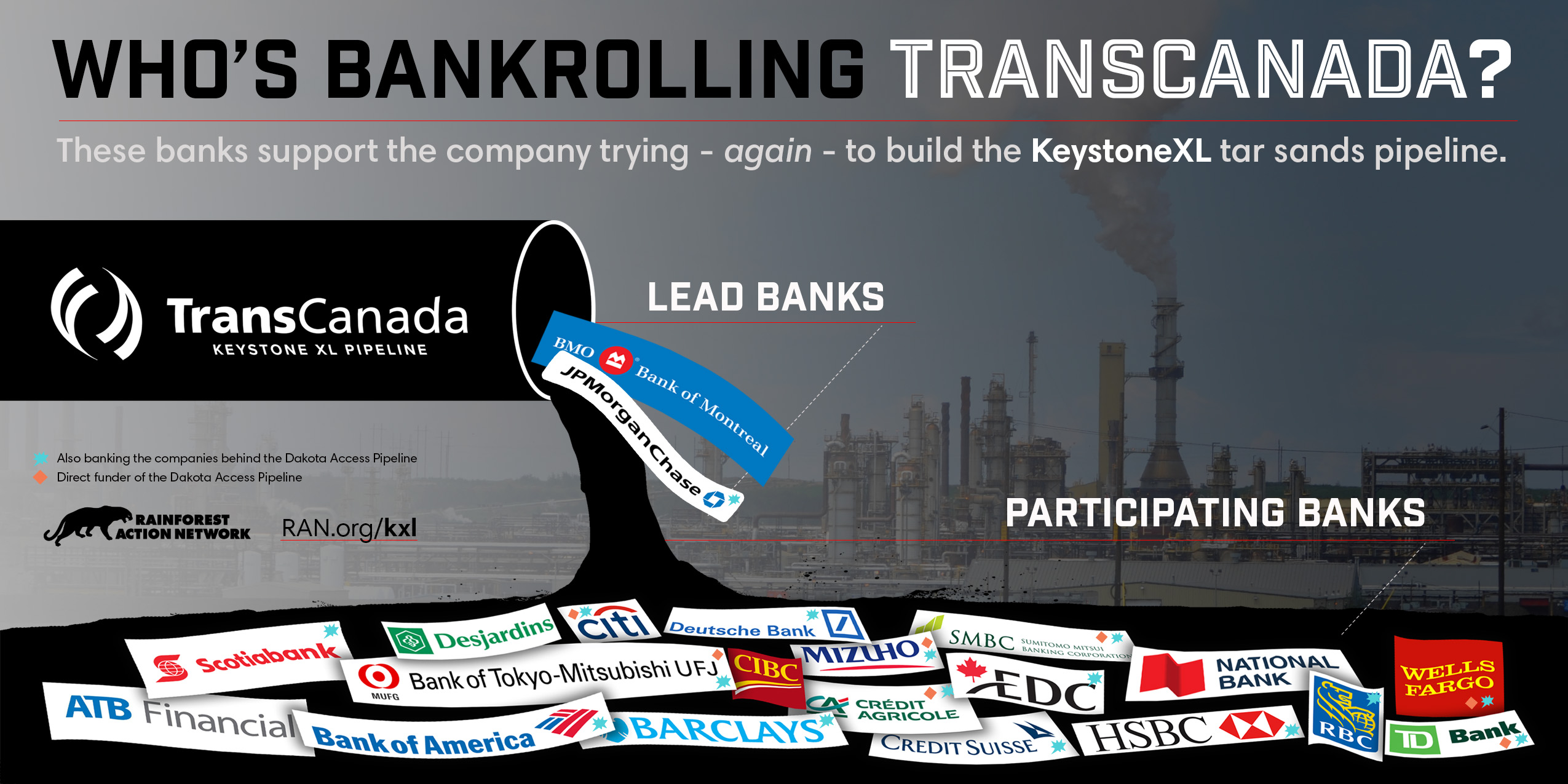Who’s banking the Coastal GasLink pipeline Feb 2020 UPDATE.
Who’s banking the Keystone XL pipeline May 2020 UPDATE.

Today, the Trump administration approved TransCanada’s latest permit to build the Keystone XL tar sands pipeline – a permit which the Obama administration had rejected on climate grounds, after massive public opposition. TransCanada is exploiting this opportunity in its decade-long battle to build this pipeline, which would run from Alberta, Canada, to Nebraska — but the pipeline is far from built. Pipelines need permits, but they also need money.
One way TransCanada could build the pipeline is to get a massive loan from a big group of banks to finance this specific project. This is probably not the most appealing option for TransCanada, given the incredible grassroots energy in opposition to the 17 banks who doled out $2.5 billion to build the Dakota Access pipeline (DAPL). It didn’t work out too well for the banks on the loan, either.
But TransCanada also has revolving credit facilities totaling over $5 billion, which act like a giant credit card for the company that it can use for operating purposes as it pleases. The fact is, TransCanada might not need new financing to build the Keystone XL pipeline — which means the banks financing TransCanada are the banks financing Keystone XL.
The graphic above shows the 21 banks that re-upped this credit as recently as December 2016. Bank of Montreal and JPMorgan Chase are the leads. 17 of these banks are behind similar credit facilities of the companies behind DAPL, while 7 of them lent to the project itself.✦
Banks like Citibank, Wells Fargo, and TD Bank, who funded the Dakota Access Pipeline, actually renewed their support for TransCanada while Indigenous water protectors and allies were resisting at Standing Rock. These banks should know better.
Tar sands is the worst type of oil for the climate and extraction has contaminated the land, drinking water, and food of First Nations people in Canada. Indigenous leaders from Alberta’s tar sands and down the entire pipeline route have resisted the Keystone XL, while TransCanada has failed to secure their consent for development on their lands. Landowners in Nebraska have also stood strong in opposition against Keystone XL, preventing permits that would allow the pipeline to cross the state.
These banks have a choice: they can walk away from TransCanada, from Keystone XL, and from tar sands. Wall Street lenders and international banks can refuse to profit from climate disaster, and join a collective global effort to build a thriving future.
We are calling on all 21 of these banks to stop banking on TransCanada. Our communities and climate can’t afford it.
✦ There are only 16 blue stars on the infographic because at the time of publication, only 16 banks of these banks were on the revolving credit facilities of the companies behind DAPL. Read more here about how CIBC is now financing the Energy Transfer family.
P.S. Here’s the full list of 21 banks on TransCanada’s revolving credit facilities:
Alberta Treasury Branches
Bank of America *
Bank of Montreal
Bank of Nova Scotia *
Bank of Tokyo Mitsubishi UFJ * ❖
Barclays *
Caisse Centrale Desjardins du Québec
Canadian Imperial Bank of Commerce * (as of March 2017)
Citi * ❖
Crédit Agricole * ❖
Credit Suisse *
Deutsche Bank *
Export Development Canada *
HSBC *
JPMorgan Chase *
Mizuho * ❖
National Bank of Canada
Royal Bank of Canada *
SMBC * ❖
TD Bank * ❖
Wells Fargo * ❖
* Also banking the companies behind the Dakota Access Pipeline
❖ Direct funder of the Dakota Access Pipeline
